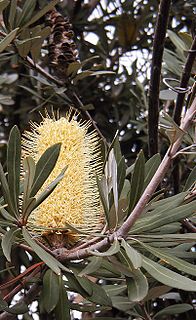
Celtis is a genus of about 60–70 species of deciduous trees, commonly known as hackberries or nettle trees, widespread in warm temperate regions of the Northern Hemisphere. The genus is part of the extended hemp family (Cannabaceae).

Lord Howe Island is an irregularly crescent-shaped volcanic remnant in the Tasman Sea between Australia and New Zealand, part of the Australian state of New South Wales. It lies 600 km (320 nmi) directly east of mainland Port Macquarie, 780 km (420 nmi) northeast of Sydney, and about 900 km (490 nmi) southwest of Norfolk Island. It is about 10 km (6.2 mi) long and between 0.3 and 2.0 km wide with an area of 14.55 km2, though just 3.98 km2 of that comprise the low-lying developed part of the island.

Banksia conferta, commonly known as the glasshouse banksia, is a species of shrub that is endemic to eastern Australia. It has rough, bark on the trunk, elliptic to egg-shaped leaves arranged in whorls, crowded yellow flowers in a cylindrical spike later forming a relatively large number of follicles.

Banksia ser. Salicinae is a valid botanic name for a series of Banksia. First published by Carl Meissner in 1856, the name has had three circumscriptions.

Banksia penicillata is a species of shrub that is endemic to a restricted area of New South Wales. It has smooth bark, serrated, elliptic to egg-shaped leaves, green to bluish flower buds, later yellow flowers in a cylindrical spike, and later still, up to one hundred narrow elliptical follicles in each spike, surrounded by the remains of the flowers.

Trophis scandens, commonly named burny vine, is a species of large woody vines, constituting part of the fig plant family. They grow naturally in rainforests in Australia and Malesia.

Sarcomelicope simplicifolia, commonly known as bauerella, hard aspen or yellow-wood, is a species of flowering plant in the family Rutaceae and is endemic to eastern Australia including Lord Howe and Norfolk Islands. It is a shrub or small tree with elliptic to egg-shaped leaves arranged in opposite pairs, male or female flowers arranged in small groups in leaf axils and fruit an oval to spherical drupe.

Eucalyptus loxophleba, commonly known as York gum, daarwet, goatta, twotta or yandee, is a species of tree or mallee that is endemic to Western Australia. It has rough bark on the trunk, smooth olive to brownish bark above, lance-shaped adult leaves, flowers buds in groups of between seven and eleven, white flowers and conical fruit.

Olearia elliptica, commonly known as the sticky daisy bush, is a shrub in the family Asteraceae and is native to New South Wales and Queensland in eastern Australia. It has scattered, sticky leaves and white flowers in summer and autumn.

Trophis scandens subsp. megacarpa is a flowering plant in the mulberry family. The subspecific epithet comes from the Greek mega ("big") and carpos ("fruit"), with reference to the larger fruits in this subspecies.
Celtis conferta is a flowering plant in the hemp and hackberry family. It has a disjunct range in the Australasian region, with two subspecies.
Melicytus novae-zelandiae subsp. centurionis is a flowering plant in the family Violaceae. It is a subspecies of Melicytus novae-zelandiae, known in New Zealand as coastal mahoe. The subspecific epithet honours the military Captain James Doran McComish (1881–1948), who made several visits in the 1930s to collect plants on Lord Howe Island.
Apium prostratum subsp. howense is a flowering plant in the carrot family native to Australia's Lord Howe Island. The epithet howense derives from the name of that island.

Olearia elliptica subsp. praetermissa is a flowering plant in the family Asteraceae. The subspecific epithet means "overlooked", referring to the fact that this distinctive endemic subspecies was long overlooked.

Drypetes deplanchei subsp. affinis, commonly known as greybark or grey bark, is a flowering plant in the Putranjivaceae family. The subspecific epithet affinis alludes to its similarity to Drypetes sepiaria of India and Sri Lanka.
Leptospermum polygalifolium subsp. howense, commonly known as tea tree or tea-tree, is a flowering plant in the myrtle family, Myrtaceae. The subspecific epithet refers to the island to which the subspecies is endemic.
Passiflora herbertiana subsp. insulae-howei is a flowering plant in the passion flower family. The subspecific epithet refers to the island to which the subspecies is endemic.
Piper excelsum subsp. psittacorum, commonly known as pepper tree or kava, is a flowering plant in the family Piperaceae. The subspecific epithet means “of the parrots”, inferring a liking by parrots for the fruits.

Pouteria myrsinoides subsp. reticulata, commonly known as axe-handle wood, is a flowering plant in the sapodilla family, Sapotaceae. The subspecific epithet refers to the reticulate venation on the leaves.













